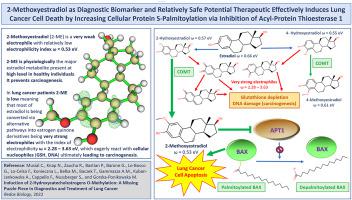Redox Biology ( IF 10.7 ) Pub Date : 2022-07-08 , DOI: 10.1016/j.redox.2022.102395 Claudia Musial 1 , Narcyz Knap 1 , Renata Zaucha 2 , Paulina Bastian 1 , Giampaolo Barone 3 , Giosuè Lo Bosco 4 , Fabrizio Lo-Celso 5 , Lucyna Konieczna 6 , Mariusz Belka 6 , Tomasz Bączek 6 , Antonella Marino Gammazza 7 , Alicja Kuban-Jankowska 1 , Francesco Cappello 8 , Stephan Nussberger 9 , Magdalena Gorska-Ponikowska 10

|
Lung cancer is one of the most common cancers worldwide, causing nearly one million deaths each year. Herein, we present the effect of 2-methoxyestradiol (2-ME), the endogenous metabolite of 17β-estradiol (E2), on non-small cell lung cancer (NSCLC) cells. We observed that 2-ME reduced the viability of lung adenocarcinoma in two-dimensional (2D) and three-dimensional (3D) spheroidal A549 cell culture models. Molecular modeling was carried out aiming to visualize amino acid residues within binding pockets of the acyl-protein thioesterases, namely 1 (APT1) and 2 (APT2), and thus to identify which ones were more likely involved in the interaction with 2-ME.
Our findings suggest that 2-ME acts as an APT1 inhibitor enhancing protein palmitoylation and oxidative stress phenomena in the lung cancer cell. In order to support our data, metabolomics of blood serum from NSCLC patients was also performed. Moreover, computational analysis suggests that 2-ME as compared to other estrogen metabolism intermediates is relatively safe in terms of its possible non-receptor bioactivity within healthy human cells due to a very low electrophilic potential and hence no substantial risk of spontaneous covalent modification of biologically protective nucleophiles.
We propose that 2-ME can be used as a selective tumor biomarker in the course of certain types of lung cancers and possibly as a therapeutic adjuvant or neoadjuvant.
中文翻译:

2-羟基儿茶酚雌激素 O-甲基化的诱导:肺癌诊断和治疗中缺失的一块拼图
肺癌是全世界最常见的癌症之一,每年导致近百万人死亡。在此,我们介绍了 17β-雌二醇 (E2) 的内源代谢产物 2-甲氧基雌二醇 (2-ME) 对非小细胞肺癌 (NSCLC) 细胞的影响。我们观察到,2-ME 降低了二维 (2D) 和三维 (3D) 球状 A549 细胞培养模型中肺腺癌的活力。进行分子建模的目的是可视化酰基蛋白硫酯酶的结合袋内的氨基酸残基,即 1 (APT1) 和 2 (APT2),从而确定哪些氨基酸残基更有可能参与与 2-ME 的相互作用。
我们的研究结果表明,2-ME 可作为 APT1 抑制剂,增强肺癌细胞中的蛋白质棕榈酰化和氧化应激现象。为了支持我们的数据,还对 NSCLC 患者的血清进行了代谢组学分析。此外,计算分析表明,与其他雌激素代谢中间体相比,2-ME 由于亲电势非常低,在健康人体细胞内可能具有非受体生物活性,因此相对安全,因此不存在自发共价修饰生物活性的重大风险。保护性亲核试剂。
我们建议 2-ME 可用作某些类型肺癌病程中的选择性肿瘤生物标志物,并可能用作治疗辅助剂或新辅助剂。











































 京公网安备 11010802027423号
京公网安备 11010802027423号